
Charter Dives
Dive Sites
While we are not offering our traditional scuba diving services in 2023, we do offer charter dives to the Sunboat wreck for experienced divers with Advanced Open Water certification (or higher) who do not need a refresher dive and who bring their own BCDs, regulators, and tanks (or equipment rented somewhere else). Those charter dives are generally self-guided dives. The skipper will give you an extensive briefing of the dive site as well as a safety briefing. We have created a “trail” for the Sunboat wreck and the surrounding small wrecks (Amphibian Vehicles and artificial reefs) by connecting all the different wrecks with a line. This will make it easy for you to find your way through the entire site. |
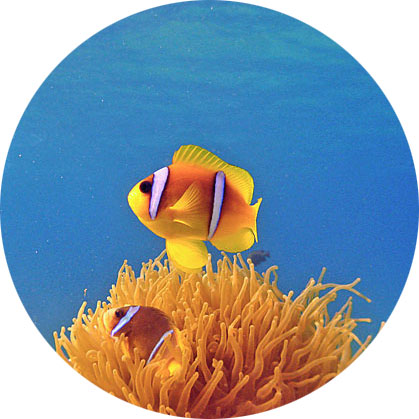 |
|
|
General Info | ||
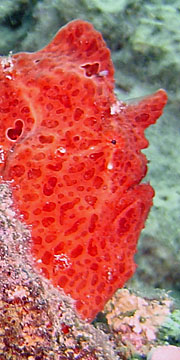 For detailed information, please read our section on Israeli diving law to learn about insurance requirements, minimum age, and maximum depths.
‘Refresher’ Dives
The
Israeli Diving Authority requires divers who haven't dived in 6 months to undergo
a ‘refresher’ dive consisting of a
special briefing and a few
underwater exercises as well as checking that you
can reasonably maintain your buoyancy. Master Scuba Divers or dive
professionals are exempt.We are not providing refresher dives in 2023. | 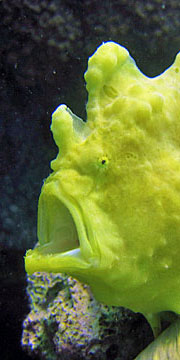 | |
|
Boat Diving
There's nothing like hopping on a boat and heading out to sea for a day of scuba diving. The Sunboat wreck, a purpose sunk boat and very successful artificial reef lies 300m from shore is best dived from a boat. It has attracted many fish species, which are otherwise rare in Eilat. 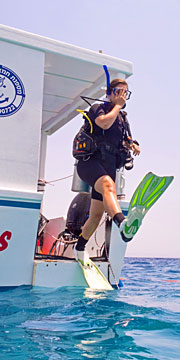 Our dive boat Ashira offers a comfortable, shaded ride and a stable platform for entering and exiting the water. Our dive boat is also available for day charters by organized dive groups. |
A Few Restrictions
If you need a 'refresher dive' under Israeli diving
regulations (see the section above), then you will not be able
to go out on the boat on your first day.
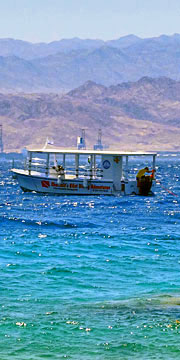 The Israel Diving Authority does not recognize the Scuba Diver certification (12m) as a valid diving certification. Dives for Scuba Divers are considered instructional dives. That means that Scuba Divers cannot participate charter dives. Also mandatory: a valid diving insurance. |
|
Eilat Dive Sites (General Information) | ||
|
We dive along the 14km (9 mi) of Israeli
coastline at the northern end of the Gulf of Eilat,
a narrow extension of the Red Sea bordered by Egypt,
Israel, Jordan and Saudi Arabia. Without
exaggeration, nobody knows these reefs better than
we do. We visit some dive sites that nobody else
goes to, either because they're unfamiliar even to
experienced Eilat dive instructors, or because they're
only accessible by boat.
What You'll See
Fun things that are
very often seen include many species of moray eels, all
kinds of scorpionfishes, stonefishes and lionfishes, octopi,
shrimps and crabs, and
various nudibranchs and shelled molluscs. We may
occasionally encounter turtles,
blue-spotted stingrays, frogfishes, eagle rays and ghost pipefishes,
but they are not everyday sightings.
Besides the dozens of species of colorful reef
fishes, we'll occasionally see predators like jacks,
both large and small barracuda species, dogtooth
tunas and Spanish mackerels. In recent years also
whale sharks and wild dolphins started to visit our
area. Dive sites are listed below in north-to-south order. Advanced sites are marked with one of the following: AOW means the site is limited to divers who are at least Advanced Open Water certified because of maximum depth of 30m (100 ft). AOW/N means that the advanced site is best dived on Nitrox. DEEP means that we can only take divers certified to dive to 40m (130 ft), either as a Deep Diver, tech diver, or dive professional. | ||
Northern Dive Sites The northern sites are located 'in town' or just outside of it, and offer a variety of unique underwater experiences as well as easy-access dive training opportunities. | ||
1. Sunboat
BOAT
The venerable Sunboat had a long and diverse history on the water, including time spent as the first liveaboard diving boat in Sinai. 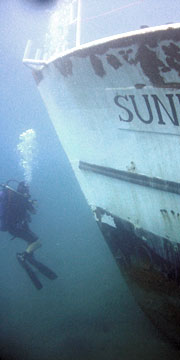 The 30m long (100 ft) wreck sits at a depth of about 15m (45 ft). In just over ten years, it has developed into a vibrant artificial reef which attracts schools of fusiliers and very often also mackerels, jacks and small tuna. The ceilings of the rooms are coated with colorful sponges and bivalves, and the mast features coral, sponges, anemones and clown fish. Frogfish, crocodile fish and “balls” of little striped eel catfish (nasrallahs) are not uncommon. Besides the shipwreck, there are other artificial reefs which consist of several amphibian vehicles and a few metal grids with lavish coral cover and teeming with fish life. 3. Underwater Restaurant
SHORE
The Red Sea Star underwater restaurant was a grandiose engineering project and spectacular business failure. Twice. 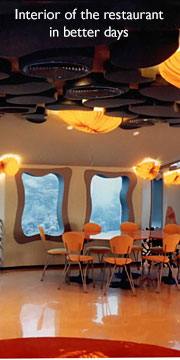 The maximum depth is about 12m (40 ft). | 2. Dekel Beach
SHORE
Dekel Beach is a great training site with a number of coral formations surrounded by colorful fishes. The beach itself is well kept, has showers and bathrooms and restaurant. 4. Song of the Sea Canyon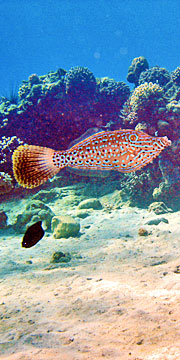
AOW/N BOAT
At the southern end of Dekel Beach, this advanced dive site has a landscape unlike any other in Eilat: a sandy channel sloping down from 18m (60 ft) to over 30m (100 ft) is flanked on both sides by coral-covered canyon walls that slope up to a healthy and diverse coral reef plateau on both sides. The coral species are different from those of the South Beach and there is a good chance to seeing nudibranchs and moray eels. Although this site can be reached from shore it makes an excellent boat dive because you drop down directly to the beginning of the actual dive site. |
|
Coral Beach Area
Some of the Coral Beach Area dive sites are among the most popular and populous in Eilat, because of the short distance from the large dive centers. | ||
5. Sufa Missile Boat (Satil)
BOAT OR SHORE
One of the most popular dives in Eilat, the Saar 3-class missile boat Sufa (Storm) was removed from active service in the Israeli Navy after 25 years and sunk in 1994 as a dive attraction. 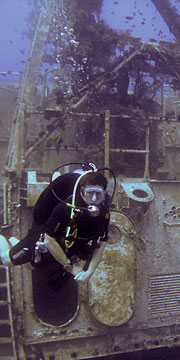 Standing upright in 25m (82 ft) of water, this 48m (150 ft) long steel-hulled former warship is accessible for all levels of divers (except Scuba Divers). The deck lies at a depth of 20m (66 ft) and so the entire superstucture and soft coral-bedecked instrumentation mast rising to a depth of 12m (40 ft) can be enjoyed by everybody. More advanced divers will enjoy a little bit of exploration in the below-decks areas opened to the sea. The history of this ship is no less fascinating than the dive itself. The Sufa was one of the famous Boats of Cherbourg (link to wikipedia page) liberated from that French seaport in a daring 1969 Israeli operation, following an export embargo imposed by French president De Gaulle. 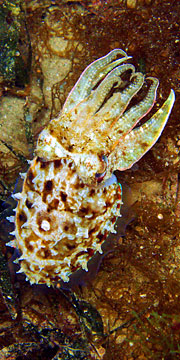 We often use the site for a Wreck Adventure Dive as part of an Advanced Open Water Course, and it's perfect for planning and executing all of the dives of the PADI Wreck Diver Specialty Course. The grassy part of the slope leading down to the wreck is also a premier location for night dives featuring nudibranchs, sea hares (in late winter), cuttlefishes and lots of other interesting invertebrates. 9. Amphi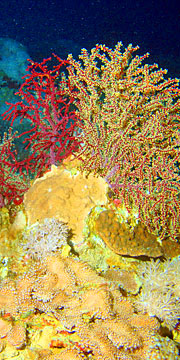
DEEP SHORE
East of the Yatush (further down the slope) is a natural amphitheater of sand surrounded by an oval bowl of dense corals, giving the area its name. The sandy bottom of the amphi is at 45m (147 ft) but a good view of the area can be had by looping around at a maximum depth of no more than 40m (130 ft). The amphi is actually one of several deep ‘amphis’ in a chain but only suitable for Tec Diving. | 6. Paradise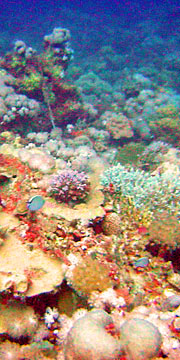 Beyond (east of) the Satil lies a seemingly endless field of dense hard corals with average depth of about 27m (90 ft). This is a nice advanced dive, and if you've got good air consumption and nitrox we can combine this site with a tour of the Satil on a single dive. 7. Infection Reef (Zihum)
AOW/N BOAT 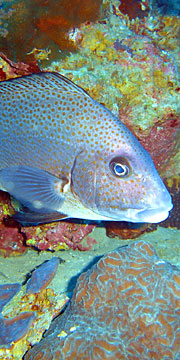 8. Netz Patrol Boat (Yatush)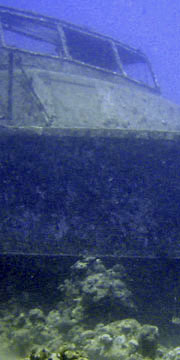 Netz-class patrol boats saw service in the Israeli Navy in the 1970s, but having been built by the US for riverine warfare in Vietnam were not well suited to the rigors of the open sea. This retired Netz-class boat was purposely dropped on the reef during the 1980s at 30m (100 ft) just north of Site No. 7, Coral Beach. It's popularly called the Yatush because at some point in time it was misidentified as one of the Yatush-class patrol boats that had been stationed on the Dead Sea and the name, inexplicably, stuck. However, at a length of only 15m (50 ft) and endowed with an aluminum hull on which nothing grows, the Yatush tself is not a very interesting wreck dive. 10. Coral Beach
SHORE
The Coral Beach area is where the large Eilat dive centers are concentrated, just north of the fence marking the northern border of the Coral Beach Nature Reserve. We avoid this place because the area is dominated by large sandy expanses and a lot of student divers. |
|
|
Coral Beach Nature Reserve
Dive Sites The 'closed' part of the Coral Beach Nature Reserve (National Park) is accessible from shore only by paying an entrance fee, or by boat. Shore access is from a wooden pier with broad stairs leading down to the water. This is excellent for snorkelers. The beach is a quiet beach and provides showers and bathroom as well a snack bar and souvenir shop. | ||
11. Japanese Gardens North
BOAT
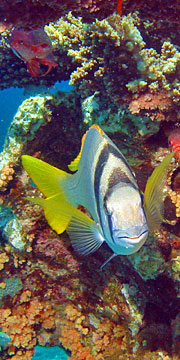 The northern Japanese Gardens boat mooring takes you to an area where different routes are possible. It has a steeply sloping reef with dense coral cover, a patch reef with lots of fish life and a shallow area right near the reef table. It is a good dive site for looking for small creatures such as different species of shrimps, pipefish, and nudibranchs. Occasionally, the pretty blue-spotted stingrays may cross your path. |
12. Japanese Gardens South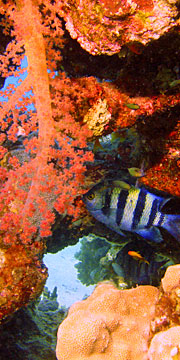 The area around the southern Japanese Gardens boat mooring boasts a steeply sloping reef down to 40m (130 ft). The mooring is located about 80m north of the tower of the Underwater Observatory. Corals are dense, diverse and healthy, especially at depth. While you can see reef fish everywhere in Eilat, this is the spot where you can find Royal Angelfish which are generally rare in our area. The area around the southern Japanese Gardens boat mooring boasts a steeply sloping reef down to 40m (130 ft). The mooring is located about 80m north of the tower of the Underwater Observatory. Corals are dense, diverse and healthy, especially at depth. While you can see reef fish everywhere in Eilat, this is the spot where you can find Royal Angelfish which are generally rare in our area. | |
|
South Beach Dive
Sites The South Beach sites are located over several kilometers just north of the Taba border crossing with Egypt. This is an area of diverse coral reefs, lively shallow coral pinnacles (bommies) and eel gardens, deep coral fields and lots of interesting fish life. Although not closed off with a fence, the South Beach is still a part of the Coral Beach Nature Reserve and the rules of the reserve still apply here – keep your hands, legs and fins off the environment! | ||
13. Lighthouse Reef
SHORE
This stretch of reef can be dived to any depth. A shallow, colorful, sunlit reef gives way to a slope that drops off to more than 30m (100 ft). 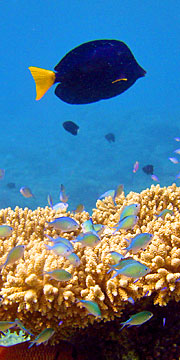 15. Wonderland
DEEP BOAT
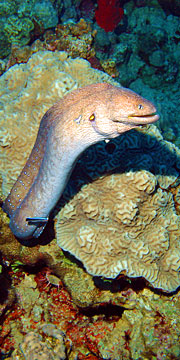 18. Veronica Rock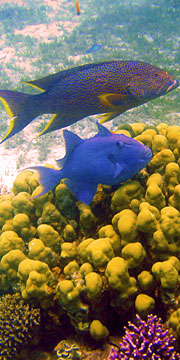 Veronica Rock is a typical South Beach site with a shallow sandy area dotted with small coral pinnacles, and a slope that falls off from about 6m (20 ft) to about 27m (90 ft). The Veronica Rock is a pinnacle at 10m (33 ft) that offers a lot of fish action. We often include Veronica Rock in our dive at Princess Garden. 20. Twin Peaks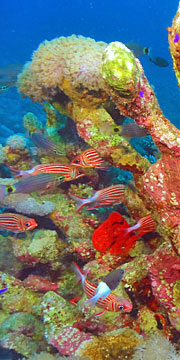 This site is one ot the three southernmost dive site in the State of Israel and one of favorites! Twin Peaks marks the southern end of the Ridge with two unique coral pinnacles literally buzzing with fish life. On our diving route we pass several colonies of blacktip groupers. Frequently, large needlefish hang around in the vicinity of the boat just below the surface. The area we'll explore is mostly a flat expanse of hard corals around 24m (80 ft). 21. Neptune's Tables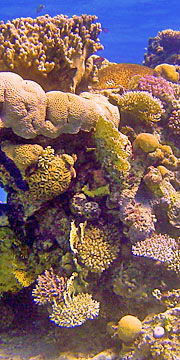 This area, south of the Princess hotel and north of the entrance to the Taba (Egypt) border terminal, has been named for the impressive acropora tables found at depth surrounded by grassy meadows. On the patch reef slope (6-25m, 20-80 ft) are large and small coral pinnacles with colorful reef fishes swimming through holes in the coral. The sandy areas of the slope are filled with large colonies of garden eels. The shallow reef table is an excellent snorkeling site and includes healthy sunlit coral pinnacles loaded with diverse sea life. Shore access is quite problematic for divers but easier for snorkelers (best via the piers of the former Princess Hotel). |
14. Three Sisters
SHORE
The name of this site speaks to the three coral pinnacles spaced out along the shallow sandy-bottomed reef table to the south. This site has been damaged badly by the 2020 storm. 16. Coral Hill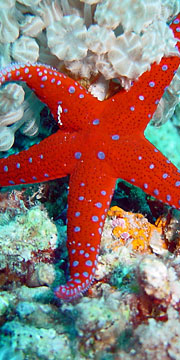 Coral Hill is an area with dense coral cover at a depth of plus-minus 30m. It is suitable for advanced divers with good air consumption and best done with Nitrox. The boat mooring lies at 28m. 17. The Ridge The Ridge is another great South Beach site where we begin our dive away from the comfort of the onshore slope and explore the reef beyond. The reef lying beyond the bottom of the Veronica Rock slope is a seemingly endless, undulating expanse of diverse hard corals, at depths mostly between 25 and 27m (80-90 ft). The Ridge extends both north and south, but unless there's a strong current coming from the north we'll go south to visit the densest and most interesting sections. 19. Princess Garden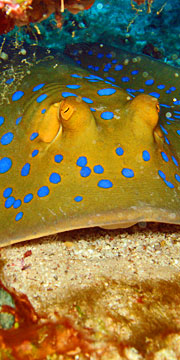 The area North of the two swimming piers of the (now-closed) Princess Hotel offers a fine area for deep and shallow exploration, and sunlit coral gardens no more than a few meters deep. At around 15m several coral formations are home to different shrimp species. It is also a nesting ground for red-tooth trigger fish. When the current is right, we return to the boat via a blue-water swim. This is a pleasant dive site for Open Water divers, with lots to see at moderate depths. | |
|
Other
‘dive
sites’ We have to mention these
because people ask us all the time. There's so much
incorrect and outdated information on the internet
that it's hard to keep up. Here are the ones we get
asked about most:
DOLPHIN REEF is not a dive site. It's a privately owned attraction where people can book diving and snorkeling experiences with trained Black Sea dolphins. This can be a nice experience, however, we strongly recommend that you do it with Dolphin Reef itself and not as a dive from Katzaa Beach hoping to see a dolphin. You can also just pay for entrance to their pleasant beach, and you may even see dolphins while enjoying their beach. THE EEL GARDEN is a shallow patch of sand in the Coral Beach training area with very few garden eels. There are more impressive eel gardens that we can visit as part of some South Beach dive sites like Neptune's Tables or Veronica Reef. TAMAR REEF (Shunit Tamar) is a small artificial reef structure at 6-8m (20 ft) in a barren, sandy area of the Coral Beach training site. Marine biology students glue corals on it to make it look alive, though it has attracted a permanent fish population. MOSES ROCK (inside Coral Beach National Park): can be dived in combination with other dive sites. It is good from inside Coral Beach National Park (entrance fee). However, if you start your dive at the Coral Beach area outside the fence of the National Park, you have a long trek over sand until you get there just to circle the Rock and return via the same dreadful route. UNIVERSITY is an extension of the Lighthouse Reef dive site (No. 14) where the students at the adjacent interuniversity marine institute have set up coral-growing experiments. THE CAVES comprises a very shallow section (3-4m, 10ft) of reef table with a couple of holes in the coral. There aren't any caves! It's heavily used for intro dives for non-divers. It's a nice, colorful area and worth a few minutes of your time (but not a whole dive). | ||
